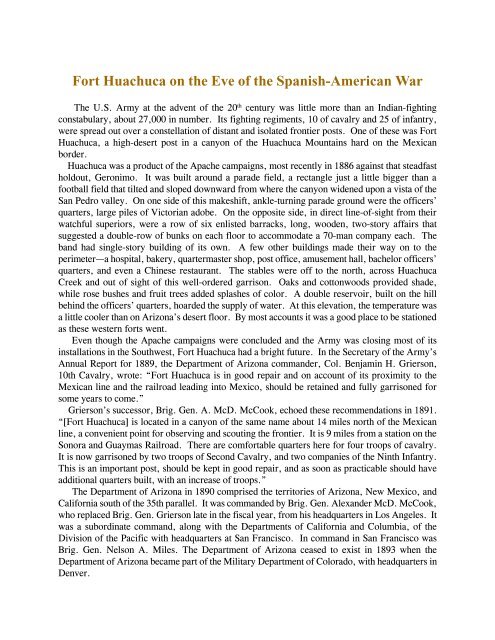Turn of the Century - Fort Huachuca - U.S. Army
Turn of the Century - Fort Huachuca - U.S. Army
Turn of the Century - Fort Huachuca - U.S. Army
- No tags were found...
Create successful ePaper yourself
Turn your PDF publications into a flip-book with our unique Google optimized e-Paper software.
<strong>Fort</strong> <strong>Huachuca</strong> on <strong>the</strong> Eve <strong>of</strong> <strong>the</strong> Spanish-American WarThe U.S. <strong>Army</strong> at <strong>the</strong> advent <strong>of</strong> <strong>the</strong> 20 th century was little more than an Indian-fightingconstabulary, about 27,000 in number. Its fighting regiments, 10 <strong>of</strong> cavalry and 25 <strong>of</strong> infantry,were spread out over a constellation <strong>of</strong> distant and isolated frontier posts. One <strong>of</strong> <strong>the</strong>se was <strong>Fort</strong><strong>Huachuca</strong>, a high-desert post in a canyon <strong>of</strong> <strong>the</strong> <strong>Huachuca</strong> Mountains hard on <strong>the</strong> Mexicanborder.<strong>Huachuca</strong> was a product <strong>of</strong> <strong>the</strong> Apache campaigns, most recently in 1886 against that steadfastholdout, Geronimo. It was built around a parade field, a rectangle just a little bigger than afootball field that tilted and sloped downward from where <strong>the</strong> canyon widened upon a vista <strong>of</strong> <strong>the</strong>San Pedro valley. On one side <strong>of</strong> this makeshift, ankle-turning parade ground were <strong>the</strong> <strong>of</strong>ficers’quarters, large piles <strong>of</strong> Victorian adobe. On <strong>the</strong> opposite side, in direct line-<strong>of</strong>-sight from <strong>the</strong>irwatchful superiors, were a row <strong>of</strong> six enlisted barracks, long, wooden, two-story affairs thatsuggested a double-row <strong>of</strong> bunks on each floor to accommodate a 70-man company each. Theband had single-story building <strong>of</strong> its own. A few o<strong>the</strong>r buildings made <strong>the</strong>ir way on to <strong>the</strong>perimeter—a hospital, bakery, quartermaster shop, post <strong>of</strong>fice, amusement hall, bachelor <strong>of</strong>ficers’quarters, and even a Chinese restaurant. The stables were <strong>of</strong>f to <strong>the</strong> north, across <strong>Huachuca</strong>Creek and out <strong>of</strong> sight <strong>of</strong> this well-ordered garrison. Oaks and cottonwoods provided shade,while rose bushes and fruit trees added splashes <strong>of</strong> color. A double reservoir, built on <strong>the</strong> hillbehind <strong>the</strong> <strong>of</strong>ficers’ quarters, hoarded <strong>the</strong> supply <strong>of</strong> water. At this elevation, <strong>the</strong> temperature wasa little cooler than on Arizona’s desert floor. By most accounts it was a good place to be stationedas <strong>the</strong>se western forts went.Even though <strong>the</strong> Apache campaigns were concluded and <strong>the</strong> <strong>Army</strong> was closing most <strong>of</strong> itsinstallations in <strong>the</strong> Southwest, <strong>Fort</strong> <strong>Huachuca</strong> had a bright future. In <strong>the</strong> Secretary <strong>of</strong> <strong>the</strong> <strong>Army</strong>’sAnnual Report for 1889, <strong>the</strong> Department <strong>of</strong> Arizona commander, Col. Benjamin H. Grierson,10th Cavalry, wrote: “<strong>Fort</strong> <strong>Huachuca</strong> is in good repair and on account <strong>of</strong> its proximity to <strong>the</strong>Mexican line and <strong>the</strong> railroad leading into Mexico, should be retained and fully garrisoned forsome years to come.”Grierson’s successor, Brig. Gen. A. McD. McCook, echoed <strong>the</strong>se recommendations in 1891.“[<strong>Fort</strong> <strong>Huachuca</strong>] is located in a canyon <strong>of</strong> <strong>the</strong> same name about 14 miles north <strong>of</strong> <strong>the</strong> Mexicanline, a convenient point for observing and scouting <strong>the</strong> frontier. It is 9 miles from a station on <strong>the</strong>Sonora and Guaymas Railroad. There are comfortable quarters here for four troops <strong>of</strong> cavalry.It is now garrisoned by two troops <strong>of</strong> Second Cavalry, and two companies <strong>of</strong> <strong>the</strong> Ninth Infantry.This is an important post, should be kept in good repair, and as soon as practicable should haveadditional quarters built, with an increase <strong>of</strong> troops.”The Department <strong>of</strong> Arizona in 1890 comprised <strong>the</strong> territories <strong>of</strong> Arizona, New Mexico, andCalifornia south <strong>of</strong> <strong>the</strong> 35th parallel. It was commanded by Brig. Gen. Alexander McD. McCook,who replaced Brig. Gen. Grierson late in <strong>the</strong> fiscal year, from his headquarters in Los Angeles. Itwas a subordinate command, along with <strong>the</strong> Departments <strong>of</strong> California and Columbia, <strong>of</strong> <strong>the</strong>Division <strong>of</strong> <strong>the</strong> Pacific with headquarters at San Francisco. In command in San Francisco wasBrig. Gen. Nelson A. Miles. The Department <strong>of</strong> Arizona ceased to exist in 1893 when <strong>the</strong>Department <strong>of</strong> Arizona became part <strong>of</strong> <strong>the</strong> Military Department <strong>of</strong> Colorado, with headquarters inDenver.
















